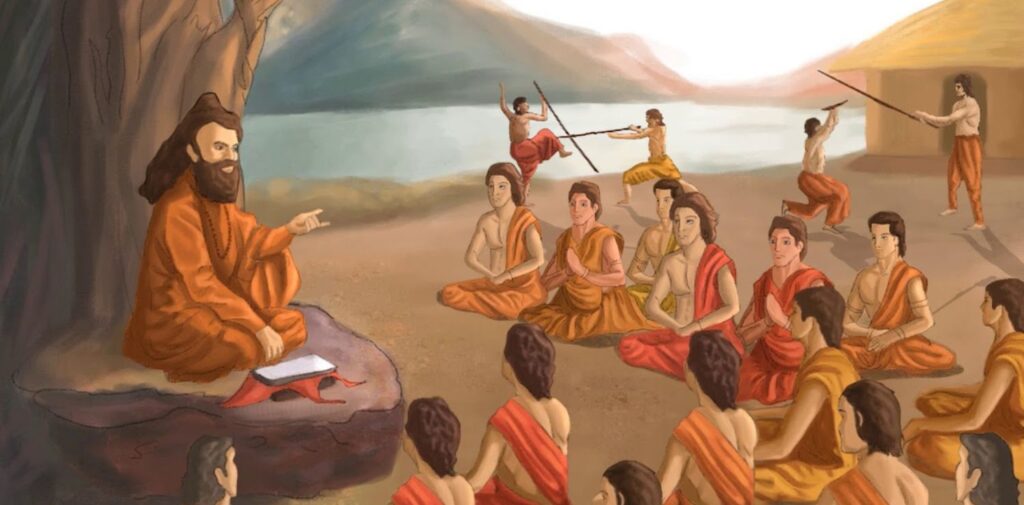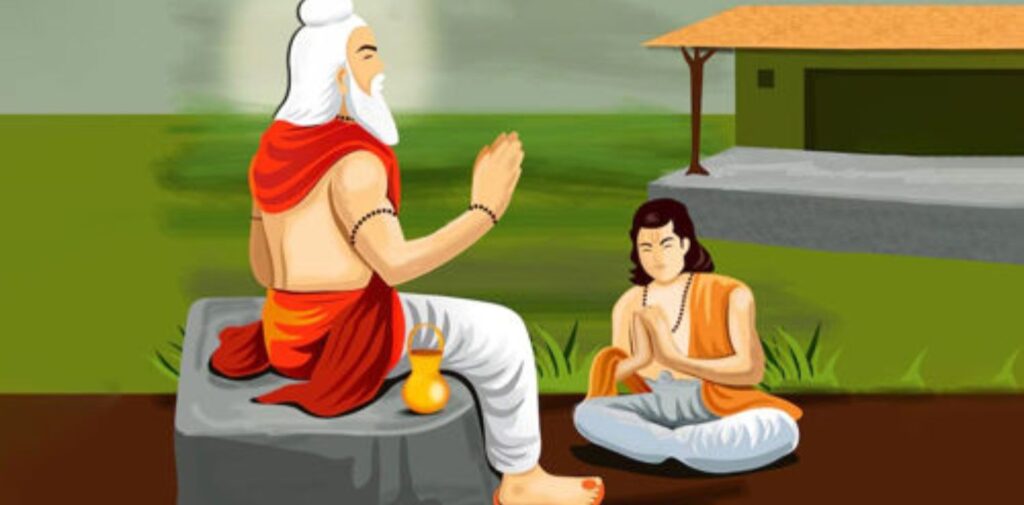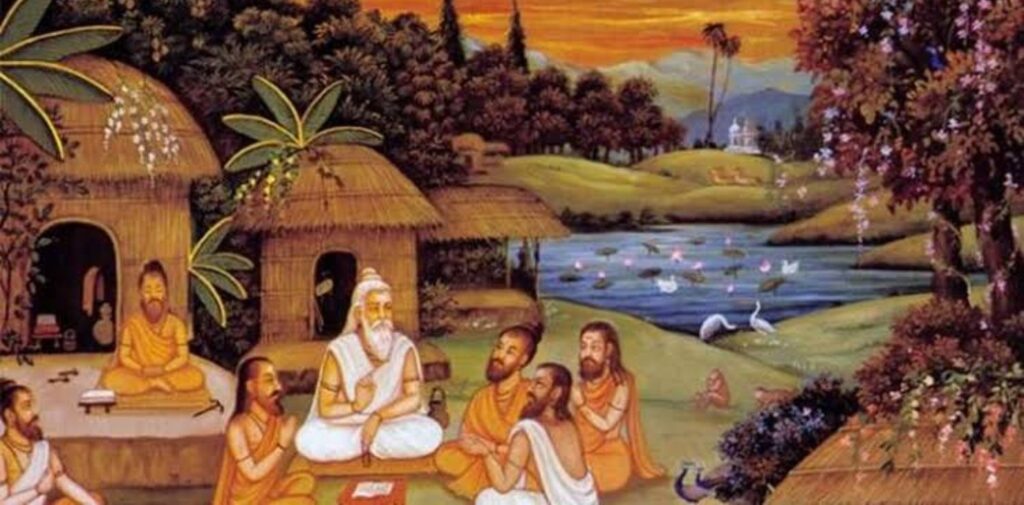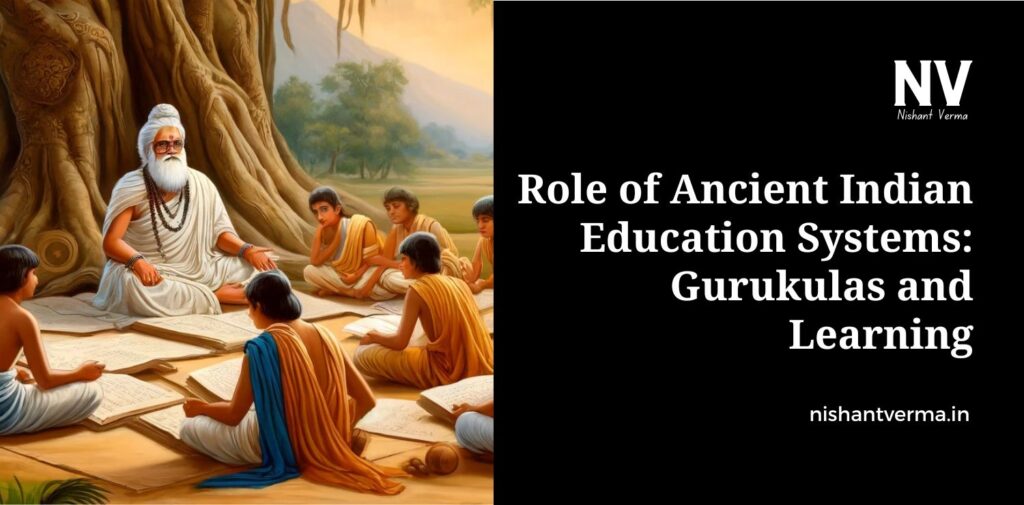India has a long and proud history, and education has always been an essential part of it. Thousands of years ago, in ancient Indian Education Systems, there were no schools or universities like we have today. Instead, there were special places called Gurukulas where children learned important lessons about life, philosophy, and science. These Gurukulas were the centers of learning that helped shape the minds of many great thinkers, rulers, and scholars who lived in ancient India.
In this article, we will take a look at how education was taught in ancient India, what Gurukulas were like, and how they played a big role in the development of Indian society.
What Was a Gurukula?
The word Gurukula comes from two Sanskrit words: “Guru,” meaning teacher, and “Kula,” meaning family or home. So, a Gurukula was essentially the home or place of a Guru, where students lived and learned under the guidance of a wise teacher. In ancient India, Gurukulas were not just classrooms but also places where students learned through experiences and close interaction with their teachers.
Gurukulas were usually located in peaceful areas like forests or villages, far from the noise and distractions of the cities. This environment helped students focus on their studies and develop a deep understanding of the subjects they were learning. The relationship between the Guru (teacher) and the Shishya (student) was very important in these learning centers.

How Did the Gurukulas Work?
In ancient India, the Gurukula system was based on the idea of personalized learning. Unlike modern education, where there are many students in a classroom with one teacher, in a Gurukula, the teacher gave individual attention to each student. A Guru did not just teach academic subjects but also moral values, life skills, and spiritual lessons.
Students would often stay with their Guru for many years. The teacher would guide them through various subjects, such as Vedas, philosophy, mathematics, astronomy, literature, music, and arts. They would also learn practical skills like farming, architecture, and medicine, depending on their interests and the needs of society.
The learning was not limited to books or lectures. Students would spend time in nature, observe the world around them, and learn by doing. They learned the importance of respect, discipline, and hard work, which helped them become wise and responsible members of society.
Subjects Taught in Gurukulas
The education system in ancient India was very diverse, and students learned a wide variety of subjects. Here are some of the most important subjects that were taught in Gurukulas:
- Vedas and Religious Texts: The Vedas are ancient religious texts that form the foundation of Hindu philosophy. In Gurukulas, students learned the Vedas and their meanings. They studied how to perform religious rituals, understand spiritual concepts, and follow the principles of dharma (righteous living).
- Philosophy and Logic: Students were taught how to think logically and understand complex ideas. They learned about different schools of thought, the nature of life and the universe, and the meaning of existence.
- Mathematics and Astronomy: Ancient Indian scholars made significant contributions to mathematics and astronomy. Students in Gurukulas learned about numbers, geometry, and the stars. They studied the movement of planets, timekeeping, and calculations related to space.
- Literature and Poetry: Gurukulas were also places where students developed their love for stories, poems, and epics. They learned to read and write Sanskrit and studied great works like the Ramayana, Mahabharata, and Puranas.
- Medicine and Healing: Many Gurukulas offered teachings on Ayurveda, which is an ancient system of medicine. Students learned about the human body, herbs, and natural remedies for diseases.
- Arts and Crafts: The arts were highly valued in ancient Indian education. Students learned music, dance, painting, sculpture, and other crafts. These subjects helped students express themselves creatively.

The Guru-Shishya Relationship
One of the most important aspects of the Gurukula system was the relationship between the Guru (teacher) and the Shishya (student). In a Gurukula, the teacher was not just an instructor but also a guide, mentor, and friend. The Guru would help the students with their studies and also teach them how to lead a good life.
This relationship was based on deep respect. The students would treat their Guru with great reverence and learn from the wisdom and experience of their teacher. In return, the Guru would guide the students with patience and care, helping them grow into wise and capable individuals.
The bond between the teacher and student was also one of trust. The Guru would take care of the student, providing for their needs and ensuring that they learned everything they needed to know. This close, personal bond made education in Gurukulas very different from modern schools, where there are many students and less personal interaction.
The Role of Gurukulas in Ancient Indian Society
Gurukulas were not just places for academic learning; they played an important role in shaping society. They were the backbone of Indian culture, and the knowledge passed down through them helped to develop many aspects of life in India.
- Promoting Wisdom and Knowledge: Gurukulas were centers of knowledge where ideas were exchanged and new discoveries were made. Scholars from different parts of India came to these learning centers to share their knowledge and learn from each other.
- Spreading Religious and Philosophical Teachings: Since many Gurukulas taught religious texts and philosophy, they played a significant role in spreading the spiritual teachings of Hinduism, Buddhism, and Jainism. They helped students understand the importance of values like truth, non-violence, and compassion.
- Developing Future Leaders: Many kings, scholars, and thinkers of ancient India were educated in Gurukulas. The education they received helped them become wise rulers, responsible citizens, and great thinkers who contributed to the growth of India. The values taught in Gurukulas, such as fairness and justice, influenced their decisions and actions.
- Building Strong Communities: The Gurukulas helped strengthen the bonds within communities. They were places where people gathered not only to learn but also to discuss ideas and share experiences. Students who graduated from Gurukulas often returned to their communities and passed on their knowledge to others.
Decline of the Gurukula System
Over time, the Gurukula system began to decline. This was partly because of the foreign invasions in India, which led to the destruction of many ancient learning centers. The arrival of British colonial rule in the 18th century also brought about changes in the education system. Western-style education replaced the traditional Gurukula system in many parts of India.
Despite these changes, the legacy of Gurukulas continues to influence education in India today. The values of respect for teachers, the importance of learning, and the connection between education and life remain important parts of Indian culture.

The Legacy of the Gurukula System
The Gurukula system had a lasting impact on Indian education and culture. It was based on the idea that education should be holistic, focusing not just on academic knowledge but also on personal growth and moral development. The bond between the Guru and the Shishya was a powerful force for shaping the minds of the students, teaching them the importance of wisdom, respect, and discipline.
Even today, many of the values that were taught in Gurukulas, such as respect for knowledge, respect for teachers, and the importance of a well-rounded education, are still relevant in modern education systems.
Conclusion: Indian Education Systems
The Gurukula system was an essential part of ancient Indian society. It provided a place for students to learn, grow, and become wise individuals. The education they received in these places helped shape the culture, values, and knowledge of India for centuries.
The legacy of the Gurukula system continues to inspire educators and students today. It reminds us of the importance of education that goes beyond just reading and writing – an education that helps us become better, wiser, and kinder people.




